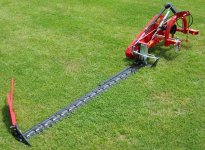Birdhunter1
Veteran Member
I spent the summer after high school working for the county highway department, having years of experience on our farm with tractors I was put on the mowing crew, amongst other duties that us young guys with strong backs were put to use for.
Of the two tractors I had a choice of one was a newer John Deere (I think a 5200) and an old Ford 3400, both two wheel drive. The first time I got on that old Ford was the last day I got on that John Deere, the low belly and wide track of that Ford made it awesome for roadside banks. I would chicken out long before that tractor became unstable, one particular hill that I drive by often as it is close to my house, is the upper limit of my pucker factor. I would not put a tractor on that hill again, but that old Ford rode it out.
Two thoughts from this thread so far, it is clear that some of you would not be able to mow highway roadsides, and two it is clear to me that if my tractor only has single rear wheels I much prefer a two wheel drive old low belly tractor.
Now throw a set of duals on a machine with a batwing I will change my mind.
Of the two tractors I had a choice of one was a newer John Deere (I think a 5200) and an old Ford 3400, both two wheel drive. The first time I got on that old Ford was the last day I got on that John Deere, the low belly and wide track of that Ford made it awesome for roadside banks. I would chicken out long before that tractor became unstable, one particular hill that I drive by often as it is close to my house, is the upper limit of my pucker factor. I would not put a tractor on that hill again, but that old Ford rode it out.
Two thoughts from this thread so far, it is clear that some of you would not be able to mow highway roadsides, and two it is clear to me that if my tractor only has single rear wheels I much prefer a two wheel drive old low belly tractor.
Now throw a set of duals on a machine with a batwing I will change my mind.
